Alaska Fish & Wildlife News
June 2020
Spring Greens
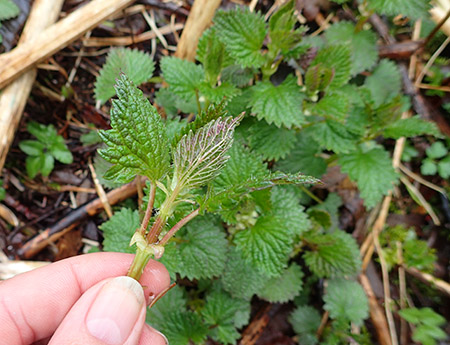
April, May and June are a bonanza for picking edible greens in Southeast Alaska. Upland plants and leaf buds usually sprout sometime in April at sunny sea level spots, and a little later in the shade of the forest, and still later at higher elevations. Beach greens also come into season at the ocean side, as do kelp in the sea.
I’m mostly an upland picker but made my first kelp harvest this year as well. Over the years, I’ve developed an outfit for gathering greens (and later, for picking berries). It includes a set of bib overalls (or raingear when called for), a hoodie with long sleeves to shield my arms and head when necessary from prickers of devils club and young salmon berry bushes, and Xtratuff boots for crossing muskegs and creeks. To hold the goods, I use quart size plastic jars - the kind you buy nuts in from Costco - that have a screw-on lid. In my early years, I used plastic coffee containers with the snap on lids, but the lids almost always came off and spilled the contents in my pack before I got home. The screw on lids stay on. A good pair of scissors in the front bib pocket completes the wardrobe and are handy for cutting fiddleheads and nettles. I also now carry a secret weapon, which I will describe shortly.
I put about 10 jars in my backpack. An empty jar goes inside the top of my bibs between the suspenders so I can pick with both hands and deposit the bounty in the jar. When I fill the jar, I screw on the lid, put it in the backpack, and start on another jar. The quart size seems ideal as it fits nicely in the bibs, and it’s not so large that it compresses the berries or greens on the bottom of the jar when it’s full.
Over the years of gathering, I stumbled on a spot near Juneau at the bottom of a mountain side where I can get all three of the spring green ingredients I need to make what I call Tongass Pesto. To get there from the road, I cross a muskeg, then down a little valley to cross a creek, then up the other side of the valley to an open mountainside. Devils club lines the valley floor on either side of the creek. The large buds that sprout in the spring taste like carrots, and are edible until the leaf starts to open up. The devils club buds can be eaten raw or cooked like most any green vegetable.
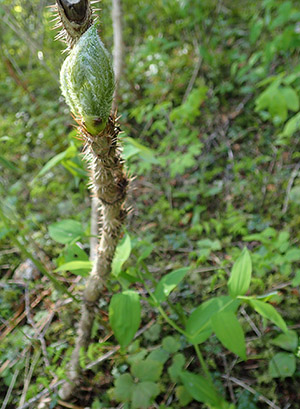
As I get older, I look back and wonder how I didn’t think of simple things a long time ago. One of those is picking devils club buds. It’s next to impossible to go five minutes without getting stuck by the devils club thorns when picking the buds off the top of a branch. Then - just this year - viola! - it came to me: salad tongs. Life changed for the better after that. I tried plain metal tongs and those with the silicone covers on the ends. Both worked, and the silicone ended tongs gave the best grip. No more nights picking out devils club thorns under a strong light with reading glasses, a sewing needle, and a pair of tweezers.
Once I get the devils club, I climb up to the open mountainside for fiddleheads, nettles (and twisted stalk). Fiddleheads are the early sprouting stage of the lady fern plant. Lady ferns grow just about everywhere around Juneau in moist soils along meadows, creeks, and in the forest, from sea level to mountainside. They don’t seem to grow in boggy soils. In the forest, fiddleheads tend to grow in little stands here and there. Large stands of fiddleheads are found on mountainside slide areas like the one I gather from that are prone to avalanches and don’t allow trees to grow. The fiddleheads in this higher country are usually ready for picking a good month after the first fiddleheads sprout at sea level, and I can gather several gallons of them in a few hours by simply snipping them off at ground level with scissors.
Early on in my gathering career, I quickly learned that cleaning fiddleheads was a tedious chore. Kind of like rockfish, which are a joy to catch and eat, but a pain to clean. Fiddleheads are picked when they are furled and covered in a tight, brown papery sheath. This sheath is difficult to remove. The most common method is to rub the sheath off in water. After an hour or two of cleaning by this method, the rookie fiddleheader realizes it’s going to take a long, long time to clean all these fiddleheads, and soon starts to call friends who have heard how good fiddleheads are to eat, but have never cleaned them. It made gathering fiddleheads a little less enjoyable, dreading the aftermath of cleaning them. Then I found one of those techniques - like the salad tongs for devils club buds - that was another life changer. It involves a pillowcase, or something like it (a nylon sleeping bag stuff sack works well), and a clothes dryer. Simply put the fiddleheads in the pillowcase, tie it off, and put the pillowcase in the dryer on air fluff for about 15 minutes. Check the progress until the fiddleheads are magically cleaned. If you get several gallons of fiddleheads, use two sleeping bag stuff sacks at the same time. This cleans the fiddleheads faster because the two bags bang into each other, along with the tumbling of the dryer.
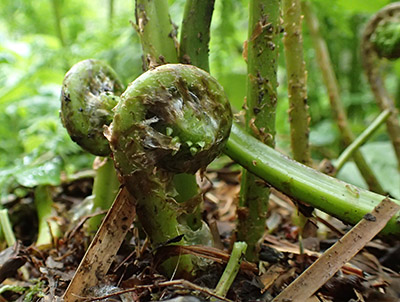
For me, the morning is the best time to clean the fiddleheads. That’s because I’m mostly retired and my wife still works. I’ve had a few episodes where I didn’t secure the pillow case well enough before putting it in the dryer, and when I checked later, I had fiddlehead chaff all over the inside of the dryer. By starting the cleaning in the morning, I have time to vacuum out the dryer before my wife gets home if any mishaps occur.
Once the fiddleheads are cleaned, I pour them into a salmon egg basket used in canneries. These baskets have square holes large enough to allow the chaff to fall through, but small enough that the fiddleheads do not. By shaking the basket, the chaff falls through and the fiddleheads stay put. The fiddleheads can then be rinsed off to clean off any remaining loose chaff. If a few fiddleheads need further cleaning at this point, rub them across the bottom of the basket to remove their chaff. I usually have a little chaff left in between the furls of the fiddlehead and don’t notice it when eating.
Once cleaned, fiddleheads are usually steamed or boiled, and afterward, sauteed like fresh green beans. They should be steamed or boiled first before sauteeing, and the cooking water discarded, since they can give some people gastric discomfort if eaten raw. Raw fiddleheads can also be pickled. The University of Maine Extension Service has more fiddlehead information and recipes.
On the same hillside where I gather fiddleheads I also find twisted stalk and stinging nettles. Twisted stalk is virtually everywhere, and I’ve only eaten it fresh. The leaves taste like cucumber. This plant produces “watermelon berries” in late summer, watery berries with a mild flavor. Nettles seem to grow exclusively along the banks of the little rivulet valleys that come down the hillside. Nettles will cause a sting if picked with bare hands, so I wear gloves and use scissors to clip off the tops. Nettles lose their sting with just a half minute of steaming, and can be used as a cooked leaf as you would spinach, or as a tea.
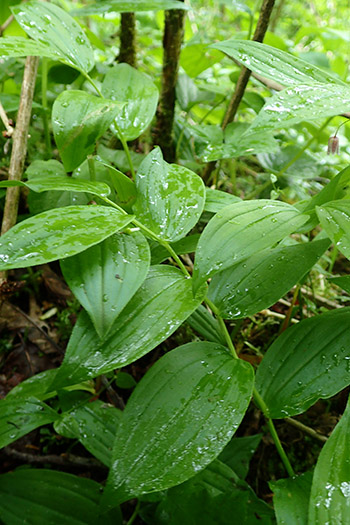
Over the years, I’ve tried preserving the devils club buds and fiddleheads by pickling or freezing, and the nettles by freezing. Pickling is kind of fool proof, if you like pickles. Some people say to blanche the fiddleheads before freezing, but they came out mushy that way for me. For freezing, I’ve had better luck putting them in a colander in the refrigerator for a day or two so they dry out a tad, and then freezing them raw. I freeze the nettles the same way.
The best and most versatile way I’ve found to preserve all three plants, thought, is to make a pesto and freeze it (recipe below). You can vary the amount of the three greens based on your taste and the amount of each you have. Of the three, the devils club buds have the strongest flavor - sort of citrusy - and the pesto can be used like a basil pesto in seafood and pasta dishes. I freeze the pesto in ice cube trays, then vacuum pack four cubes per bag.
Bull kelp is another “green” I harvested for my first time in May. Bull kelp grows from spore to mature plant in a single year, and I wrote about it in the May edition of the Alaska Fish and Wildlife News. Bull kelp is made up of a stipe and fronds. Fronds are the long leafy part of the plant that can be used like many other leafy kelps. The prize of the bull kelp is the stipe - the long, thick, fleshy air bladder. This part of the kelp can be used like a cucumber or a firm tomato or a tomatillo. It can also be made into pickles by simply cross cutting “donuts” and jarring them in a pickling solution.
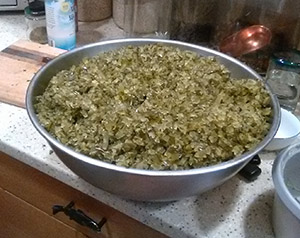
The kelp is easy to harvest, although you need a boat in most cases to get to them. We found young plants in May, and merely pulled on the bulb to release them from their holdfast on the bottom. We placed the stipe and attached fronds in a cooler to keep them cool until we got home. To process them, I first cut off the fronds from the stipe with scissors. The fronds were hung on strings to dry to use as you would any other dried kelp, or can be used as a great fertilizer for the garden.
I cut the stipe into small enough pieces to load them in a food processor to grind to a finely diced consistency. You could also use a meat grinder. The skin of the stipes can be peeled with a vegetable peeler, or the skin left on. Be aware that once out of the water, stipes with the skin on are one of the slipperiest foods you will ever try to grip. I could barely get them from the bowl into the food processor. I tried peeling a few, and they are alot easier to grasp.
Once processed, the chopped bull kelp stipe lends itself beautifully to relish, salsa and chutneys. It also freezes well. Many recipes can be found in Dolly Garza’s book, Common Edible Seaweeds in the Gulf of Alaska. It’s a crop you can gather a substantial volume in a short time, and then can enough relish, salsa and chutney to last all year. Kelp salsa goes well with chips, and kelp relish and a little mayonnaise goes great with canned salmon.
Tongass Pesto
By Mark Stopha
Greens: chop before measuring:
Fiddle Heads: 4 cups
Stinging Nettles: 4 cups
Devils Club buds: 1.5 cups
4 cloves garlic
1/4 cup lemon juice
6 oz. almonds
Olive Oil
1. Steam the greens, then shock them in cold water and put in a colander to drain.
2. Grind the almonds in a blender or food processor, and remove.
3. Put the cloves of garlic and lemon juice in the blender/food processor.
4. Add some olive oil
5. Then add a handful of each of the greens and the almonds.
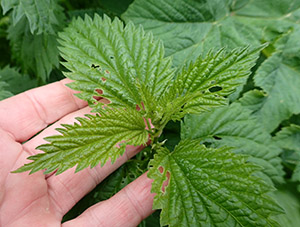
6. Pulse or blender on low and add some more olive oil to get it to mix.
7. Continue adding handfuls of each item and oil until it's all in there.
8. Pour the pesto into a bowl and add more olive oil for your desired consistency.
9. Add salt and pepper to taste.
Pour into ice cube trays and freeze.
You could add more garlic and almonds to taste, and use other nuts such as pine nuts. You could also try adding some twisted stalk.
Spruce Tip Syrup
(Riley Woodford, from Cooking Alaskan)
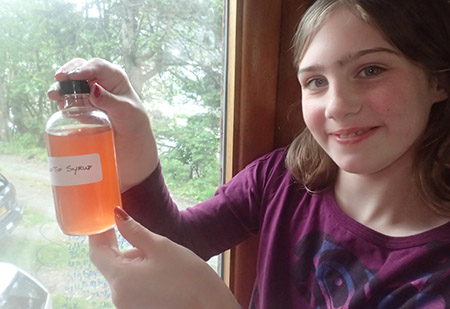
In the spring the new growth at the tip of Sitka spruce branches is soft and tender. We don’t eat the greens but use them for flavor (although they’re popular with porcupines and other animals). We make about a pint of syrup in a batch, but proportions can be easily modified as it’s basically equal parts.
2 cups spruce tips
2 cups sugar
Put spruce tips in a pot and add water so they are covered. Heat to a low boil for two hours, then strain out all the spruce tips. Add sugar and cook down to a syrupy consistency.
Editor’s note: This article is not intended to be an identification guide. If you are unfamiliar with these plants use a guide to positively identify them. Some sources advise against eating fiddleheads and devils club once the leaves are developed – eat the young, budding plants. I always sample a new food in a small portion at first, although I applied the spruce tip syrup pretty generously to my pancakes.
Mark Stopha is a Juneau outdoorsman, writer, and former ADF&G fishery biologist and commercial fisherman. He co-owns the Alaska Wild Salmon Company. He has previously written about fishing, hunting, trapping, salmon hatcheries and research, and caring for your catch for Alaska Fish and Wildlife News.
Subscribe to be notified about new issues
Receive a monthly notice about new issues and articles.

